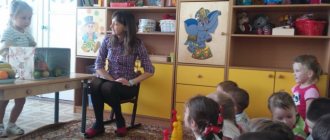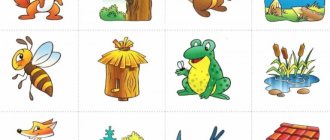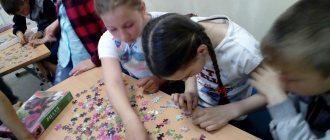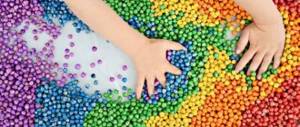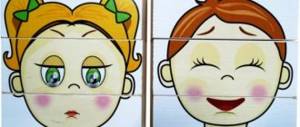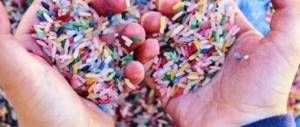Master class “Making a game for sensory development”
Author:
Konovalova Nadezhda Leonidovna,
Educator
MADOU d/s No. 65g. Tyumen
The success of mental, physical, and aesthetic education largely depends on the level of sensory development of children, that is, on how perfectly the child hears, sees and touches the environment.
This sensory game allows children to get acquainted and learn to use surrounding objects, manipulate them, and communicate through speech. These educational games affect the child’s brain through tactile sensations, developing fine motor skills, as well as thinking and speech.
In order to make a game for sensory development, we will need caps from milk tetra bags. They differ from juice caps in that they have a thin plastic border, which will give a more aesthetic appearance to our game. We will also need colored cardboard, glue or double-sided tape (whichever is more convenient), stickers with a diameter no larger than cork, scissors, and a pencil.
We cut out the corks, wash them, dry them and tear off the excess paper, leaving only the plastic edge.
We cut out any shape from cardboard (triangle, circle, butterfly, etc.), they should turn out to be two identical parts. We leave one part intact, and on the other we cut out circles, as many as you wish, according to the diameter of the unscrewed plug.
We twist the plugs from the rings and insert the required number of rings into the holes. Apply glue or double-sided tape to one part. We connect the parts very carefully so that the plugs do not fall out. We are waiting for the glue to dry.
Next, carefully insert our stickers into the holes, gluing them in the center. After this, you can screw the plugs into place.
Our game is ready.
The child is asked to unscrew the cap, look inside and describe or name the object drawn in the picture.
Educator of MADOOU d/s No. 65
Konovalova Nadezhda Leonidovna
We invite teachers of preschool education in the Tyumen region, Yamal-Nenets Autonomous Okrug and Khanty-Mansi Autonomous Okrug-Yugra to publish their teaching materials: - Pedagogical experience, original programs, teaching aids, presentations for classes, electronic games; — Personally developed notes and scenarios of educational activities, projects, master classes (including videos), forms of work with families and teachers.
Why is it profitable to publish with us?
1. 1. “Kindergartens of the Tyumen Region” is an officially registered specialized media outlet at the federal level. 2. The activities of the editorial office are supported by the Department of Education and Science of the Tyumen Region 3. We issue a “Certificate of Publication” in the media. 4. The document has a unique number, is entered in the register, has the original seal of the editorial office of the online publication and signature. 5. “Certificate of publication” in the media is sent to the author in both paper and electronic versions. In detail In detail >>> Sample “Certificate of publication of author’s methodological material in the media”.pdf
Share
Card index of games on sensory development for the 2nd junior group
Didactic games can be combined with fine arts lessons. It is not necessary to study according to templates, since the production of the material can be entrusted to children. We must not forget that children's play should remain light and relaxed.
Note! It is necessary to exclude situations where entertainment turns into exercise, otherwise it can cause rejection in children.
"Nuts in the Nest"
Goal: development of fine motor skills of the hands, exercise for fixing colors.
Materials: egg carton, paints, brushes, jar of water, peeled walnuts.
Progress: the child makes a house for nuts. Each compartment in the egg carton is painted a different color. Then the nuts are decorated. The next task is to move the nut to the appropriate house.
Goal: develop the ability to find a pair, correlate colors, patterns and sizes.
Materials: cut out palms of different shapes and sizes. They should be multi-colored and patterned.
Progress: the child must arrange all his palms in pairs.
"Magic bag"
Goal: to develop the ability to determine the shape of objects by touch.
Materials: bag, small cubes, balls and other shapes, maybe flat, cut out of cardboard.
Progress: the teacher names the form, and the student quickly pulls it out of the bag.
"Build a Truck"
Goal: consolidation of knowledge about the shape and size of an object.
Materials: cardboard and scissors.
Progress: at the beginning of the lesson, children cut out the required number of shapes, from which they will then need to fold a truck (two circles, a rectangle and a square). The teacher shows how they can be folded into a vehicle, and the children repeat. The figures can be glued onto cardboard and then decorated.
DIY didactic game for children 2-4 years old on sensory education
Master class on the production of material for a didactic game on sensory education for younger preschoolers “Feed Kolobok”
Author: Nadezhda Aleksandrovna Petrinko, teacher, MDOU Child Development Center - Kindergarten No. 56, Yaroslavl Description: this master class is intended for teachers, narrow kindergarten specialists, as well as caring parents. Purpose: Didactic game on sensory education for children of primary preschool age. This game is aimed at developing sensory and fine motor skills in younger preschoolers. Goal: to create a didactic game for children of primary preschool age. Objectives: • Learn to create teaching aids with your own hands; • Increase the level of competence of preschool teachers in the implementation of sensory education for preschool children; • Enrich the developmental environment of preschool group rooms.
Materials: • Thick cardboard; • Colored printer paper (or self-adhesive paper); • Glue (transparent super glue); • Scissors; • Stencils of vegetables, fruits, berries (or printed pictures); • 2 sets for spices (plastic, shown below in the photo); • 4 pairs of plastic eyes (or make eyes from self-adhesive paper). Progress of work: First, cut out a 20x20 cm square from cardboard. This will be the so-called stand (base) for the future game.
Next, we will prepare the “food” for “Koloboks”. To do this, you can trace vegetables, fruits and berries on a stencil onto colored paper and cut them out. Or, as I did, download pictures from the Internet, print them on colored double-sided paper and cut them out. I made three copies each (banana, lemon, pepper, apple, eggplant, grapes, blueberries, blackberries, watermelon, tomato, cucumber, plum, strawberry, cabbage, pear). The idea is that we need products in 4 colors - red, blue, yellow and green. I chose these food products to make it more convenient for children to play.
After the “food” is ready, we need to start creating the Koloboks themselves. For this we need these containers. I bought them in a “one price” store (inexpensive, aesthetically pleasing, quite durable, easy to open and close). In order for the Koloboks to “come to life” we need eyes and a nose.
So, take the eyes and glue them with super glue (it is possible to make eyes from self-adhesive). Now all that remains is to glue the nose and the Kolobok is ready!
Using the same scheme, we make the remaining three Koloboks.
Next, take a sheet of prepared cardboard and stands for Koloboks and glue them with super glue. The game is ready! The course of the game is individual for each child. You can invite your child to look at what color Koloboks’ nose is and, accordingly, feed him only those foods that are similar in color to it. During the game, you can ask your child questions such as: • What kind of fruit (berry, vegetable) is this? • How many vegetables (fruits, berries) did Kolobok eat? • What color is the nose of this or that bun, etc. Thank you for your attention! Dear colleagues, I wish you success, creative and professional growth.
We recommend watching:
Didactic games for children of the first junior group Educational game “Shape, color, size” for children 2-3 years old Adaptation games in kindergarten Game with logic blocks for children of primary preschool age
Similar articles:
Games, songs, exercises for younger preschoolers “Igralochka”
Educational games for children 2-3 years old in kindergarten. Card index
Outdoor games for young children in kindergarten
Didactic game for children 2-3 years old “Let’s feed the doll lunch”
Didactic game for children 2-3 years old “Dolls visiting children”

